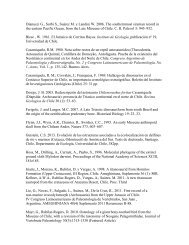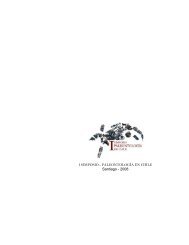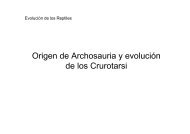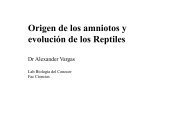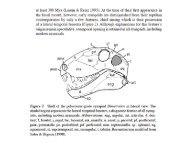Peces y Anfibios - Laboratorio de Ontogenia y Filogenia
Peces y Anfibios - Laboratorio de Ontogenia y Filogenia
Peces y Anfibios - Laboratorio de Ontogenia y Filogenia
Create successful ePaper yourself
Turn your PDF publications into a flip-book with our unique Google optimized e-Paper software.
Las Myxines (hagfishes) y Lampreas<br />
actuales vivientes son vertebrados<br />
extremadamente basales, sin mandíbulas.<br />
Ambos poseen una lengua especializada que<br />
permite raspar e ingresar comida, branquias<br />
en forma <strong>de</strong> bolsillo, y una piel sin escamas<br />
Los <strong>de</strong>más peces vivientes son<br />
Gnathostomata, que poseen mandíbulas.<br />
Los Gnathostomata <strong>de</strong>scien<strong>de</strong>n <strong>de</strong> formas<br />
fósiles acorazadas sin mandíbulas,<br />
conocidos con el termino parafilético<br />
“Ostraco<strong>de</strong>rmos”. Los primeros peces con<br />
mandíbulas (Placo<strong>de</strong>rmos) eran acorazados.<br />
One of the recently published vertebrate tree topologies that<br />
entails cyclostome paraphyly (after Gess et al., 2007;<br />
possible position of myllokunmingiids modified according to<br />
Janvier, 2003); the distribution of the taxa through time is<br />
indicated by bold lines in the time scale to the left. Major<br />
synapomor- phies at no<strong>de</strong>s: 1, neural crests, epi<strong>de</strong>rmal<br />
placo<strong>de</strong>s, fin radials; 2, <strong>de</strong>rmoskeleton in mouth and<br />
pharynx; 3, extensive <strong>de</strong>rmoskeleton over the entire body; 4,<br />
extensive lateral-line system enclosed in grooves and canals,<br />
vertical semicircular canals forming loops, cerebellum; 5,<br />
endoskeleton lined with calcified cartilage or perichondral<br />
bone; 6, pectoral fins in postbranchial position; 7, jaws.



